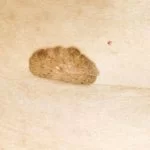Seborrheic keratosis (seb-o-REE-ik care-uh-TOE-sis) is a common and benign skin growth. These raised spots can worry people when they first notice them, as they may resemble a wart, a weird mole or even a skin cancer. They are in fact completely harmless, but to be sure that a seborrheic keratosis is what you have, any new and suspicious growth should be checked out by a dermatologist.

Since seborrheic keratosis (SK) tends to run in families, people often recall that their parents or grandparents had similar spots. And in fact over 80 million Americans report a SK. according to one study. They may occur on the face, neck, chest, back, stomach and even arms and legs but are never seen on palms and soles. Colors range from white to black with most appearing tan or brown and size ranges from tiny to up to an inch across. Overall appearance varies from waxy, warty, scaly to splattered stucco-like. Although they may occur singly most patients report multiple SKs and even clusters of them. Many seem almost “stuck-on” which has led some to call them “barnacles of aging”, since they usually appear after age 40 and we acquire more as we age. They rarely hurt but can sometimes be itchy or irritated, which may necessitate treatment. Although the cause of these nuisances is unknown, they are clearly NOT contagious.

Once you have had a SK checked out by a dermatologist you can leave it be. Occasionally a SK can mimic a more dangerous growth such as a skin cancer and in that case, your dermatologist will recommend a skin biopsy to remove it. The growth will be sent to a pathologist for examination under the microscope. Most SKs can be diagnosed simply by looking at them. Treatment may be recommended if a lesion is irritated or frequently catches on clothing or jewelry. A patient may elect to have the lesions removed for cosmetic or aesthetic reasons.

Treatment options include cryosurgery (freezing with liquid nitrogen), electrosurgery (burning with electric current), curettage (scraping with a special instrument), and ablation (vaporizing with a laser). The FDA just approved another treatment, which is a very strong hydrogen peroxide solution that is applied in the office. Side effects of treatment may include a lightening of the skin afterwards. Scarring and infection are rare. Do-it-yourself treatment at home is discouraged because of the risk of infection.
